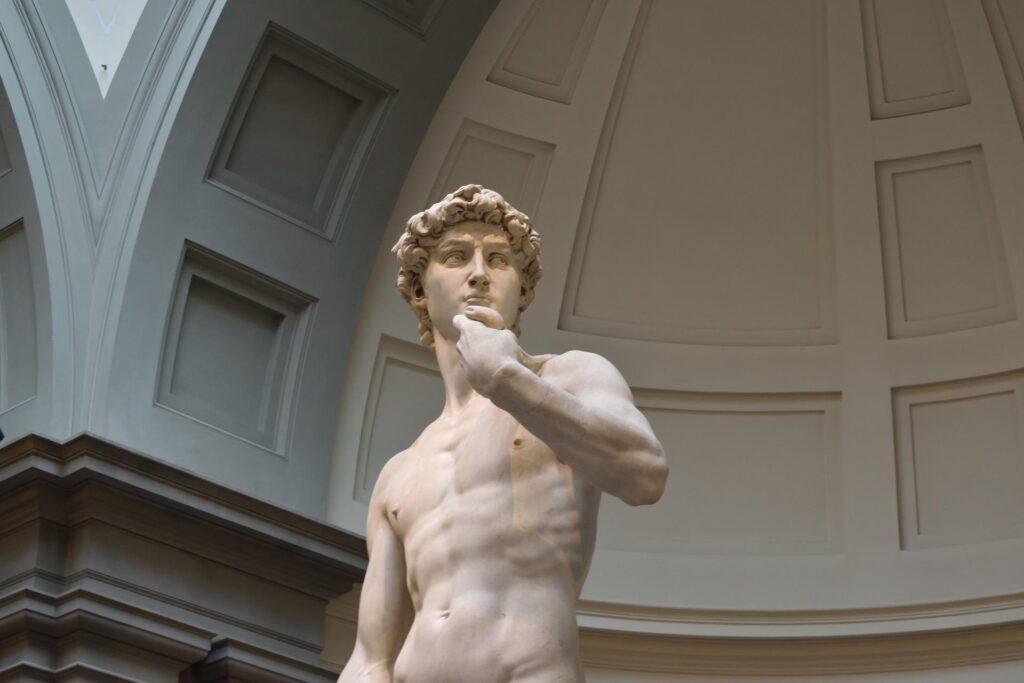The statue of David is one of the most iconic Renaissance sculptures, having enduring appeal through the centuries. Michelangelo’s renowned art continues to captivate the imagination and attract visitors to marvel at its artistic sophistication and finesse today, more than five centuries after it was originally commissioned.
Why is the Statue of David so famous?
The Statue of David is one of the most famous sculptures in the world. Created by Italian artist Michelangelo between 1501 and 1504, the statue depicts the Biblical figure of David in all his muscular glory.
What sets the Statue of David apart from other sculptures is Michelangelo’s skillful use of light and shadow to create a sense of movement and life.
The statue is also an excellent example of Renaissance humanism, which emphasizes the beauty and dignity of the human form. Today, the Statue of David remains an iconic symbol of Florence, Italy, and a timeless masterpiece of Western art.
The History of the Statue of David
Although it was initially intended for the Cathedral of Florence, a city council committee later decided that it would be more appropriate to station at Piazza Della Signoria, in the heart of Florent political activity.
The historic sculpture would remain on public display there for more than three centuries before being moved to Galleria dell’ Accademia in 1873. A copy of the statue remains in the famous Piazza.
The sculpture is based on the historical biblical figure David but was in fact the first portrayal of David before his battle with Goliath. The legend described in Samuel I provides a glimpse into an extraordinary encounter between the two.
Set near the valley of Elah, the fable captures a looming battle between Israelites and Philistines. Goliath, a heavily built champion of Philistines, challenges Israelites to send their champion for a single decisive combat. Only David, a young shepherd, steps forward.
Refusing to don armor offered by King Saul, as it’s too heavy for him, he makes his way toward Goliath with just his sling and five stones. He quickly launches a stone using his sling which strikes Goliath on his forehead, knocking him out. David then steps forward to cut Goliath’s head off.
An Inspirational Story
As one of the most renowned narrations of the Old Testament, the story has inspired innumerable artistic pursuits, but Michelangelo was the first to capture David before his engagement with the Philistine champion, Goliath.
In another contrast with most other illustrations of David, Michelangelo also chose to portray him as a young man rather than the boyish outlook embraced by others before him. With a sling over his shoulder and a look of determination on his face, Michelangelo depicts David readying for his combat with Goliath.
An Iconic Piece of Art
The iconic piece of art is also conspicuous for its mammoth dimensions. At 17 feet tall, the depiction was substantially larger than Michelangelo’s other projects. The scale, perhaps, is a testament to the originally intended location, the roof of the Cathedral of Florence, where a smaller statue might not have captured the attention of audiences to a desirable degree.
Despite being an epitome of Renaissance architecture and captivating Florentines and foreign visitors alike, David has not been able to completely elude damage. The mammoth statue, which took 4 days and 40 men to take it to its destination at Piazza Della Signoria, has also been a target of protestors and vandalizers.
In fact, as early as 1527, within decades of being put into public view, protestors had broken the statue’s left arm. As its first destination for more than three centuries was outdoors, it was also prone to natural damage.
But even after it was moved to a relatively protected indoor setting of a museum, vandalizers have not given up, with an Italian artist smashing David’s toe with a hammer in a famous 1991 incident.

